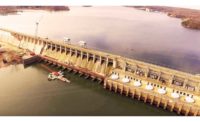Owner: Ameren Missouri
Lead Design Firm: Rizzo Associates
General Contractor: MC Industrial, a McCarthy Holdings Co.
Civil Engineer: Brayman Construction Corp.
Hydro Demolition: Rampart Hydro Services LP
Concrete Placement: ACI Concrete Placement
It’s a common misconception that Hoover Dam is the nation’s oldest concrete gravity dam. The Bagnell Dam, which created the Lake of the Ozarks in Missouri, started construction in 1929 and was completed before construction on Hoover Dam even started. Many of the techniques used on Hoover Dam were first tried on Bagnell. Today, Bagnell is still pushing the specialty construction envelope with a reconstruction that includes new anchor technology as well as a concrete resurfacing.
In 2017, owner Ameren Missouri decided to stabilize the 453-ft-long, 148-ft-tall gravity dam. The $52-million job would require 67 post-tensioned anchors and 17,000 cu yd of concrete.
“They chose these anchors because they have a restressable head,” says Mike Hartwig, project manager on the stabilization for MC Industrial. “The anchors they put in in the ’80s were more of a traditional strand tie-back anchor. You couldn’t access those to see if there’s any appreciable corrosion built up in them. The really nice part about these new anchors is that they have a removable cap, and you can pull on the strands, do tests. If you still have tension in those cables, then they’re still sound.”
Each anchor has 2 million lb of hold-back capacity. MC Industrial also resurfaced the dam using moving forms that served as scaffolds while the concrete was being placed.
Demolition subcontractor Rampart Hydro Services of Coraopolis, Pa., designed and built a robot to demolish 3 in. of exterior concrete before it was replaced. Brayman Construction of Pittsburgh provided specialty drilling and grouting services for the anchors, which took at least two grout and redrill cycles to place properly.
Asked if a less extensive stabilization strategy could have worked, Warren Witt, director of hydro operations for Ameren Missouri, says it wouldn’t have.
“This dam, besides holding back water for us to be a power plant … creates a billion-dollar tourism industry for the state of Missouri,” Witt says. “The tourism business, real estate market, thousands of homes and everything out here would be at risk.”








Post a comment to this article
Report Abusive Comment